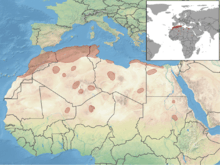North African gerbil
| North African gerbil Dipodillus campestris | |
|---|---|
| Scientific classification | |
| Kingdom: | Animalia |
| Phylum: | Chordata |
| Class: | Mammalia |
| Order: | Rodentia |
| Family: | Muridae |
| Genus: | Dipodillus |
| Species: | D. campestris |
| Binomial name | |
| Dipodillus campestris (Loche, 1867) | |
 | |
| Synonyms | |
|
Gerbillus campestris (Loche, 1867) | |
The North African gerbil (Dipodillus campestris) is a species of rodent in the family Muridae. It is found in North Africa where its natural habitats are arable land and rocky areas of the Maghreb, and hot Saharan deserts.
Description
The North African gerbil has long soft fur and a relatively long tail. The dorsal fur is cinnamon to orange-brown. Each hair has a grey base, a sandy or golden-brown terminal section and often a black tip. The cheeks and throat are white and there is sometimes a dark stripe on the nose. The underparts are white, with a clear division between the dorsal and ventral colours. The legs and feet are white and the soles of the feet are bare. The tail is about 40% of the length of the head-and-body, and is bicoloured, golden-brown above and white below. The tip of the tail forms a pencil, a tuft of longer hair.[2]
Distribution and habitat
The North African gerbil is found in Algeria, Egypt, Libya, Mali, Morocco, Niger, Sudan, Tunisia, and possibly Chad and Mauritania.[1] Its habitat varies across its range, but in general it favours habitats with rocks and vegetation rather than sand.[2]
Ecology
The North African gerbil lives in a burrow that it digs and is a terrestrial and nocturnal mammal. The timing of breeding depends on location, but in Egypt coincides with the winter rains, and in North Sudan follows the short wet season in September to November. The litter size is about five. The diet of this rodent has not been studied.[2]
Status
The North African gerbil is a common species that flourishes in a range of different environments and in some locations, such as in Morocco, it is reckoned to be an agricultural pest species. The International Union for Conservation of Nature has rated the conservation status of this rodent as being of "least concern".[1]
References
- 1 2 3 Granjon, L.; Amori, G.; Hutterer, R.; Kryštufek, B.; Yigit, N.; Mitsain, G.; Palomo, L.J.; Aulagnier, S (2008). "Gerbillus campestris". IUCN Red List of Threatened Species. Version 2011.1. International Union for Conservation of Nature. Retrieved 31 October 2016.
- 1 2 3 Jonathan Kingdon; David Happold; Thomas Butynski; Michael Hoffmann; Meredith Happold; Jan Kalina (2013). Mammals of Africa. A&C Black. pp. 302–303. ISBN 978-1-4081-8996-2.
- Musser, G. G. and M. D. Carleton. 2005. Superfamily Muroidea. pp. 894–1531 in Mammal Species of the World a Taxonomic and Geographic Reference. D. E. Wilson and D. M. Reeder eds. Johns Hopkins University Press, Baltimore.
